We transition from the battlefield to the sea. Sea people leap and dive in the water. We don’t hear them sing, something they do around this point in the book, but it’s great to see them at all. The camera pans up to the Castle Cair Paravel, which looks as beautiful as I could imagine or better than that.
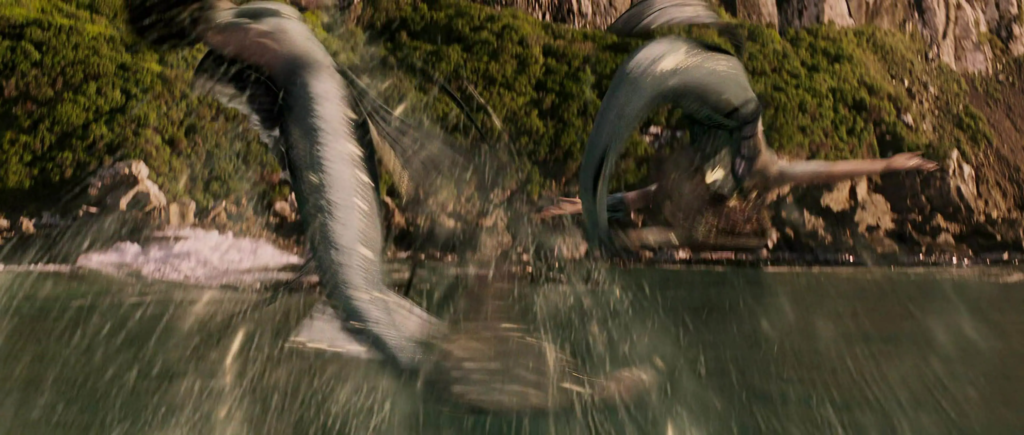

Aslan leads Peter, Susan, Edmund and Lucy, all four dressed in beautiful Narnian garb, to the fabled four thrones. The beavers stand with two silver crowns for Edmund and Lucy and two golden crowns for Peter and Susan on cushions. In another Narnia book, The Magician’s Nephew, C. S. Lewis describes dwarf-made Narnians crowns as “not ugly, heavy things like modern European crowns, but light, delicate, beautifully shaped circles that you could really wear and look nicer by wearing.” I think the movie’s designs live up to that description nicely. Tumnus, whose amusing idea of formal wear is a dress scarf and nothing else, places a crown on each Pevensie’s head as Aslan gives a speech. “To the glistening eastern sea, I give you Queen Lucy the valiant, to the great western wood, King Edmund the Just, to the radiant southern sun, Queen Susan the Gentle and to the clear northern sky, I give you King Peter the Magnificent. Once a king or queen in Narnia, always a king or queen in Narnia. May your wisdom grace us until the stars rain down from the heavens.” In the book, those titles (valiant, just, etc.) are acquired by the Pevensies after years of reigning and they make more sense that way, but I understand why the movie didn’t feel like it had time to explain that and I don’t mind Aslan knowing what they would become, either through supernatural foresight or seeing their potential. This speech has some great shoutouts for fans of the book series. All the geographical information Aslan mentions comes from there and the stars raining down from the heavens is exactly what happens when the world of Narnia comes to an end in The Last Battle. Of course, a persnickety fan might point out that in The Horse and his Boy, a Narnian character says his fellow citizens have no use for sayings about wishing for their monarchs to live forever. (“I don’t want him to live forever and I know he’s not going to live forever whether I want him to or not.”)
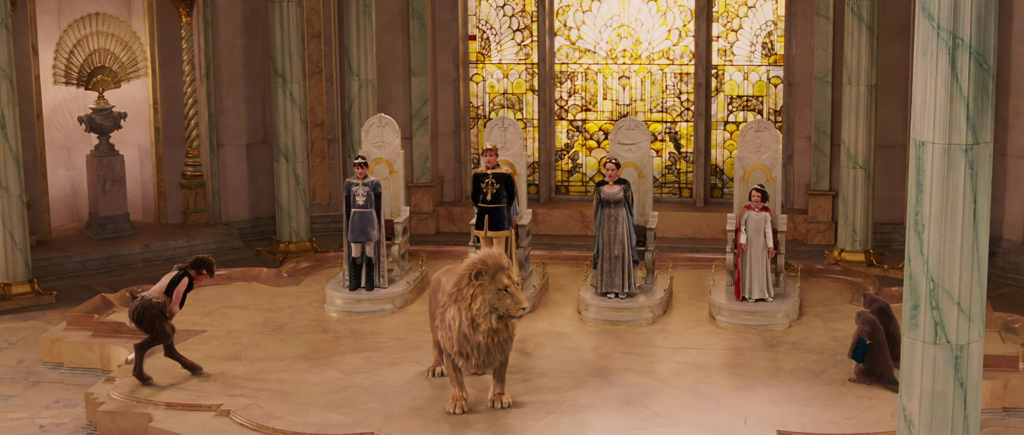
Aslan leads the guests in chanting, “Long live King Peter! Long live Queen Susan! Long live King Edmund! Long live Queen Lucy!” In a fun little gag, Mr. Beaver shouts, “long live Queen Lucy,” while his wife shouts, “long live Queen Susan!” Among the crowd, we see the fox has been saved from being a statue by Aslan.[1]C. S. Lewis never mentioned if the equivalent of the fox’s character was turned back in the book but he assured a younger reader that he was in a letter. If you have quick eyes, you can see a couple of badgers in the corner of another shot. Hopefully, one of them is the badger who was a friend of Mr. Beaver and whom the Witch turned to stone for helping Tumnus. More prominently, in the same shot as the fox, you can see the stone lion from the Witch’s courtyard, restored to flesh and blood but still with the moustache and glasses Edmund drew on her. Lewis described that act of Edmund’s as “something very silly and childish,” so he probably would disapprove of the visual joke. But I guess I’m silly and childish because it makes me laugh.
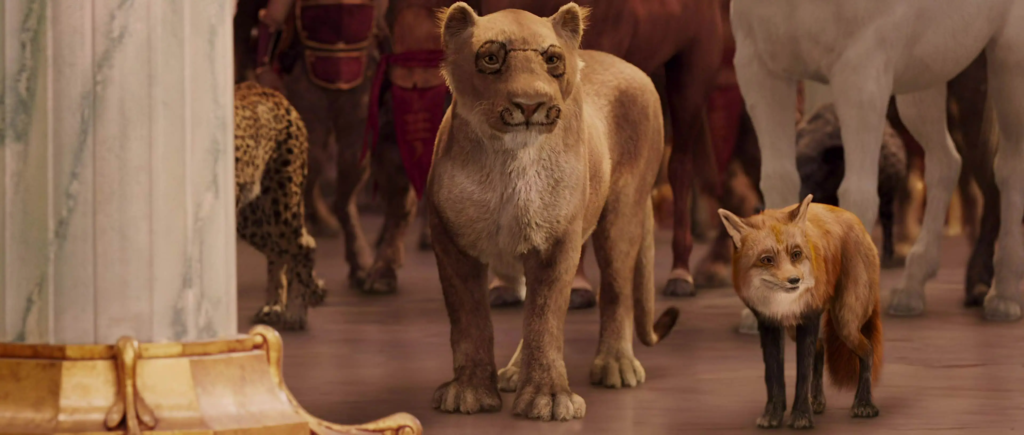
Later, we see Aslan walking along the beach, away from the castle. In the books, Aslan is described as always coming to Narnia from across the sea, so I took this as a nod to that, indicating that he’s returning to his home. On reflection though, it’s probably just because the sea is right beside Cair Paravel. Lucy runs out onto the balcony, the celebration visible behind her. She’s sad to see Aslan go without even a goodbye. “Don’t worry. We’ll see him again,” says a voice from behind her. It’s Tumnus. In the book, Mr. Beaver is the one to tell the Pevensies this and that arguably makes more sense since he and Mrs. Beaver are the main sources of exposition about Aslan and are implied to have been more devout followers of him than Tumnus. But I think the filmmakers were ultimately right to give the speech to Mr. T since his friendship with Lucy is so important, yet he has so little to do in the story. She asks him when they’ll see Aslan again. “In time,” he says ruefully. “One day he’ll be here and the next he won’t. But you mustn’t press him. After all, he’s not a tame lion.” Lucy looks thoughtful. “No,” she says, “but he is good.” Tumnus produces a handkerchief and hands it to her. “You need it more than I do,” he says. The two of them look back the seaside and see that Aslan has entirely vanished. Despite their sadness, they manage to smile acceptingly.
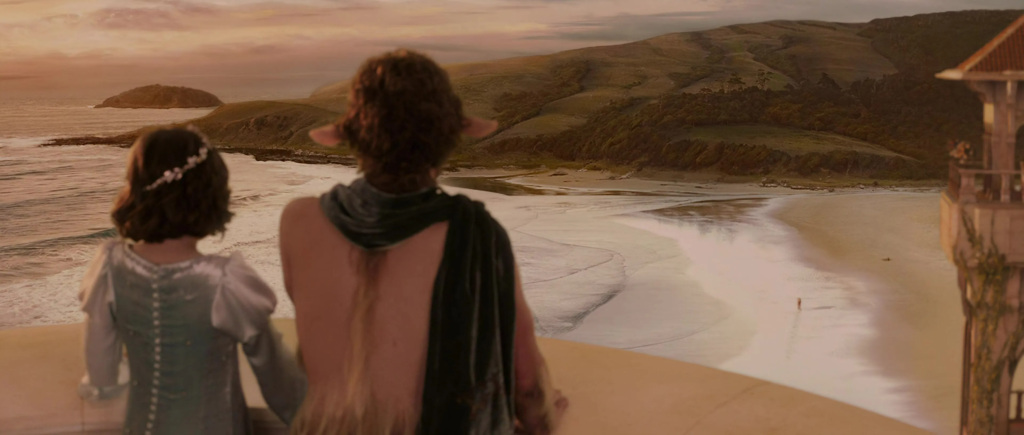
We cut to years later. The two kings and queens, now adults, are riding through the forest, hunting a stag. In the book, this is the legendary White Stag that can grant wishes to anyone who catches him. The movie doesn’t specify this, but it seems to be the subtext since they speak of “the stag,” not “a stag.” Edmund (Mark Wells-all the actors who play the Pevensies as adults are great by the way) slows down and asks his horse if he’s alright. “Not as young as I once was,” replies Philip. In this instance of riding a talking horse, I can’t even defend it by saying he’s training Edmund for war. What’s really annoying is that this the only instance in the scene of him speaking. Neither Philip nor any of the horses participates in their riders’ conversation or pays attention to what’s going on around them the way humans would. In the Narnia books, C. S. Lewis really worked out the implications of talking beasts and treated them as equals to the other intelligent species.
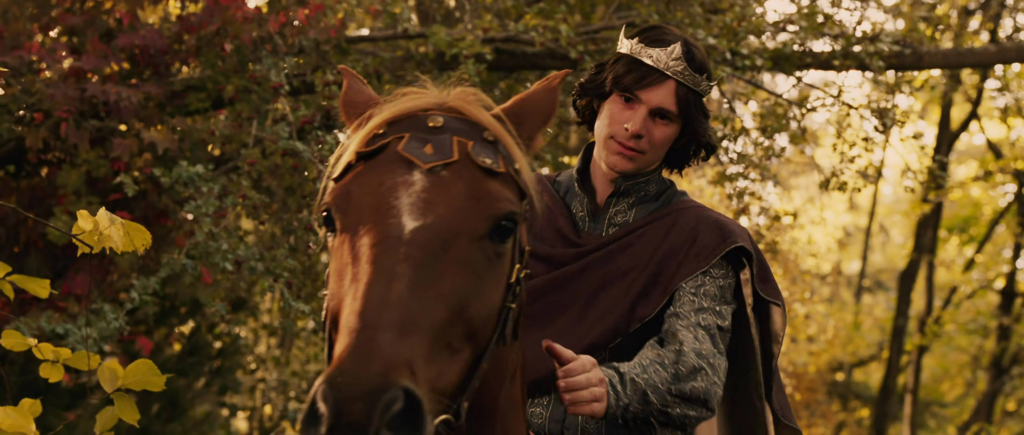
Edmund’s fellow monarchs rejoin him.
Susan (Sophie Winkleman): Come on, Ed.
Edmund: Just catching my breath.
Susan: Well, that’s all we’ll catch at this rate!
Lucy (Rachael Henley, sister of Georgie): What did he say again, Susan?
Susan: “You girls wait at the castle. I’ll get the stag myself.”
In the book, the adult kings and queens speak in a formal sounding medieval dialect. It might have been nice for the screenwriters to try to replicate this, but I don’t blame them for not doing so. Their dialogue in this scene was rather a pain to read in the book. Well, that’s to say it was a pain to read when I was a kid. As an adult who enjoys a good bit of Shakespeare now and then, I have no problem with it thought it’s still rather jarring to go from the rest of the book’s dialogue to “fair consorts, let us alight from our horses.” Anyway, the way Edmund is still a bit defensive about his sisters’ ribbing demonstrates that he’s still the same old Edmund while the concern he shows for Philip demonstrates how far he’s come. (I know I just criticized the bit with the horse, but I can have complicated opinions, can’t I?)
Everyone’s laughter fades as Peter (Noah Huntley) notices something strange and dismounts from his horse. The others follow suit. The strange thing is the lamppost, now overgrown with greenery.
Peter: What’s this? This looks familiar.
Susan: As if from a dream.
Lucy: Or the dream of a dream.
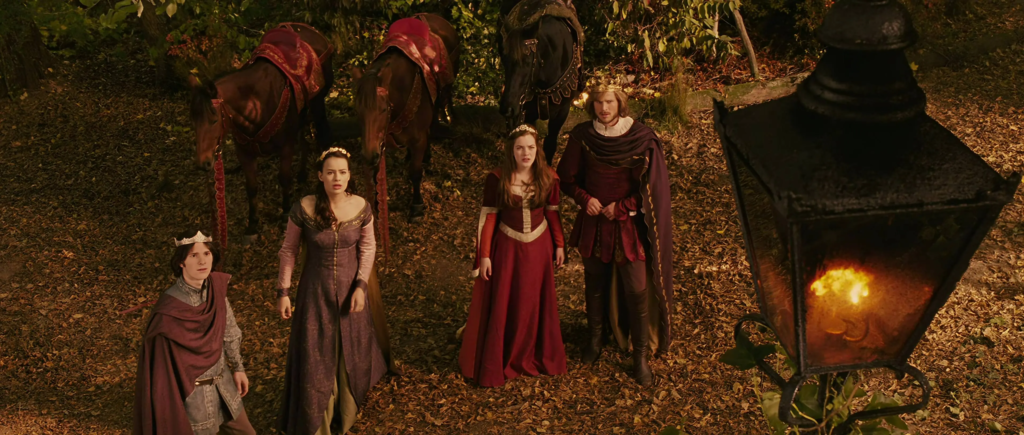
Now we get my favorite bit of humor from the movie that’s not from the book though it is riffing on one from there. As Lucy stares at the lamppost, a memory stirs in her mind. “Spare Oom?” she says, causing the others to look at her in bewilderment. She runs into the thicket, and they run after her. (“Not again,” Susan grumbles. Another good funny moment.) As the Pevensies go deeper into the woods, they find themselves brushing against fur coats rather than pine branches. Then they tumble out the wardrobe into the old spare room, their old ages again[2]By which I mean the ages they were when they first went to Narnia, not that they reverted to being in their seventies or anything. and in their old clothes. The door to the room opens and Prof. Kirke enters. “Oh. There you are. What were you all doing in the wardrobe?” he asks with a twinkle in his eye. The Pevensies stare at each other in bittersweet wonder. “You wouldn’t believe us if we told you, sir,” says Peter. The professor raises his eyebrows and tosses Peter a cricket ball. “Try me,” he says.
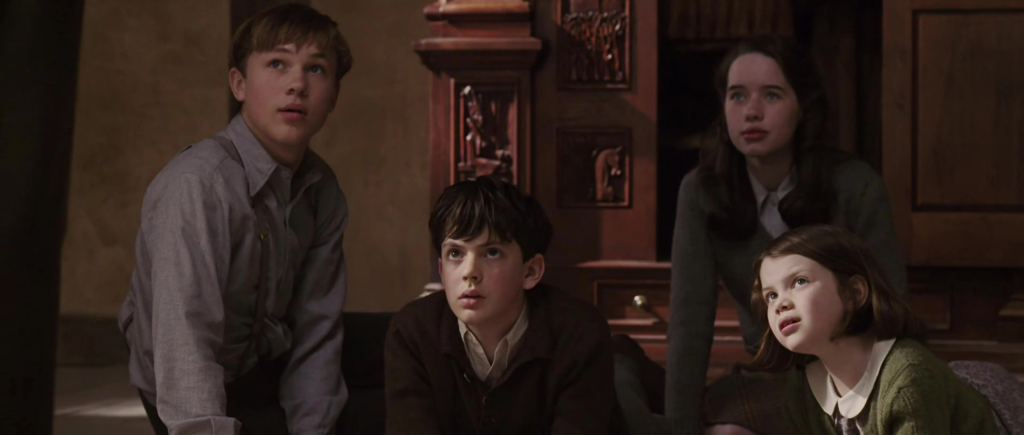
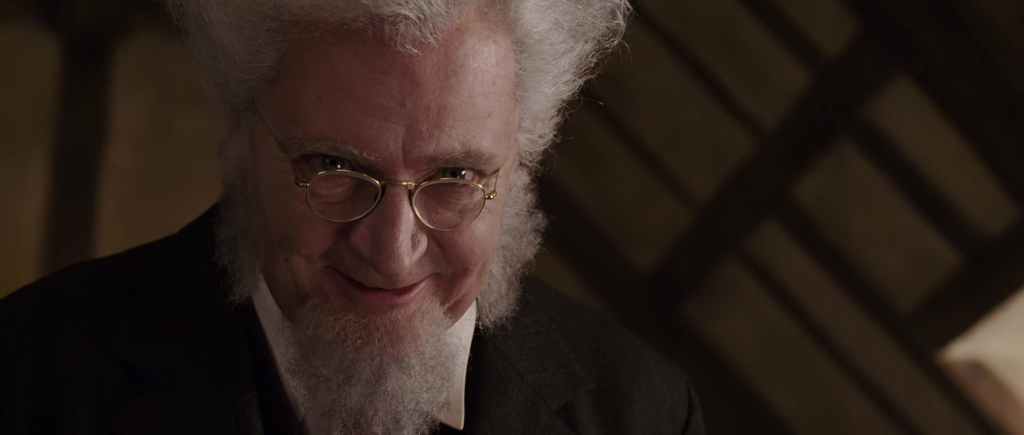
As the end credits start to roll, a pop song starts. Now there are some people who hate the idea of pop music playing over the credits of a Narnia movie or any movie that takes place long before such music was invented. Me, I don’t really think you need any songs for the end credits of any given movie. It strikes me as an extra expense when you already have a musical score you could use. And I hate the idea of pop songs in the body of a Narnia movie itself, but I don’t necessarily mind them in the credits. In fact, I think having a modern song play over the credits of a historical story can emphasize that the themes in that story are still relevant today. It’s probably a stretch though to say that any of the songs that play over the credits of this movie do that with their rather vague lyrics. But I like the first one, I Can’t Take It In by Imogene Heep. Harry Gregson-Williams’s score for the last scene does a really nice job of transitioning into it so the sudden change in musical style doesn’t jar too much and the title expresses the marvelousness of finding Narnia in a wardrobe and all that it entails.[3]Another of the credits songs, Wunderkind by Alanis Morissette is something of a guilty pleasure of mine.
Before too long, the credits pause, and we see Lucy sneaking into the wardrobe room in the middle of the night. On my first viewing, I thought this was an outtake since there was an earlier scene like this in the movie. But, no, this time Lucy has no candle and when she opens the wardrobe door, a voice behind her says, “I don’t think you’ll get back in that way.” She turns to see Prof. Kirke, sitting on the windowsill in his bathrobe and pajamas. “You see, I’ve already tried,” he says ruefully. Lucy stares wistfully into the now ordinary wardrobe. “Will we ever go back?” she asks. “I expect so,” says the professor, closing the wardrobe door, “but it’ll probably happen when you’re not looking for it. All the same, best to keep your eyes open.” In the book, the part of his speech about keeping one’s eyes open was about finding others who have visited worlds like Narnia. I think it made more sense in that context, as the professor’s advice is rather contradictory this way. (“It’ll probably happen when you’re not looking for it” but “keep your eyes open?”) Lucy takes his hand and smiles at him as they leave the room. In their absence, the wardrobe door opens a crack. Lights pour out from it along with the sound of Aslan’s triumphant roar. Both the pre-credits ending and this post-credits one beautifully capture the spirit of the book’s ending. I love that our final image is of a door closing, symbolizing how the door to Narnia is closing for us as well as the characters.
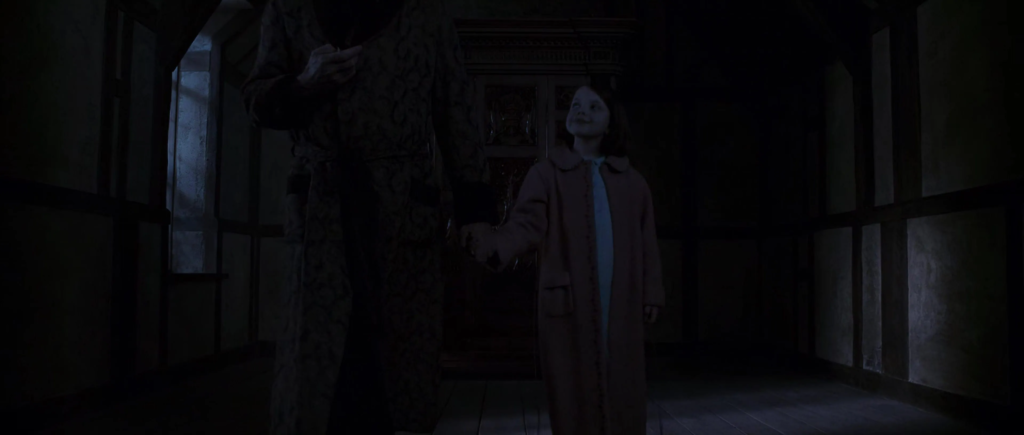
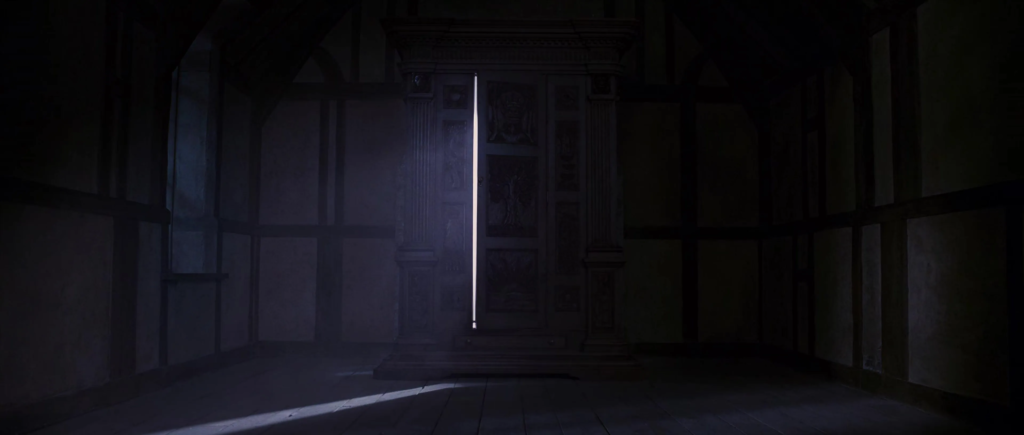
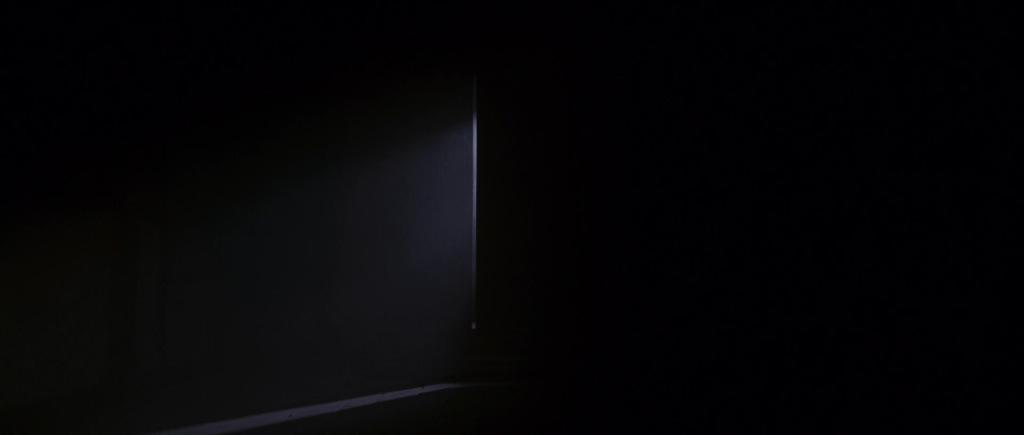
The movie is dedicated to the director’s children, Isabelle and Sylvie by the way. Aww!
Concluding Thoughts
On the whole, I think this is a great movie with a beautiful sense of childlike awe and wonder, what the source material describes as “that deep shiver of gladness which you only get if you are being solemn and still.” I think it’s got a great story with great themes, great casting, great visuals, great music. (Well, maybe not all of the music is great but enough of it is.) I don’t think however that it has a great script. That’s not to say the script is terrible or anything. But even at its best, during the first act of the story or so, I would call it solid writing rather than inspired. The uninspired elements aren’t bad enough to keep the movie from being good, but they dilute the overall quality enough to hold it back from being as great as it could easily have been. As frustrating as that is though, I honestly find movies where everything is great except for the script, as long as that script is OK rather than terrible, less frustrating than movies where the script is the only thing about them that’s great.
It should be noted that while for many readers, The Lion, the Witch and the Wardrobe is their favorite Narnia book or even the only Narnia book they consider great, for me, it’s one of my least favorites in the series if not my least favorite period. Keep in mind though that being my least favorite Narnia books means I’d only grade it an A- rather than an A or A+. So I am going to be picky about any adaptation but not as picky as some fans. I’d argue that the many of the things this one adds or expands may be untrue to The Lion, the Witch and the Wardrobe specifically but aren’t untrue to The Chronicles of Narnia in general. An emphasis on character development for the young leads and their relationships with each other, including conflict between them, is characteristic of The Horse and his Boy, The Silver Chair and The Magician’s Nephew. The Horse and his Boy and The Last Battle both feature epic battles. (It’s right in the title of the latter!) And even the short battle at the climax of the next Narnia book, Prince Caspian, is described in more detail than the one at the climax of The Lion, the Witch and the Wardrobe.[4]There’s also a case to be made that girl characters were more likely to be involved in action scenes in later Narnia stories. If you’re mainly a fan of the specific book which this movie adapts, you may not love it. But if you’re a fan of Narnia in general, you very well may. If I’m being completely honest, I kind of enjoyed seeing the familiar story be told in a different style. I even kind of enjoyed things like focusing more on the four children than on Aslan. It made me think about The Lion, the Witch and the Wardrobe from a different angle. I don’t believe it improved on the book as a whole and I’ll always wish it had been truer to some aspects of it. But I believe I’ll also always enjoy the movie for what is.
Phew! It’s been taxing doing one blog post per week for so long, especially with each one being so detailed. I still intend on giving the two other Narnia movies, Prince Caspian and The Voyage of the Dawn Treader, this treatment but I intend to take a nice long break first.
Bibliography
Lewis, C. S. (1954) The Horse and his Boy. HarperCollins Publishers.
Lewis, C. S. (1950) The Lion, the Witch and the Wardrobe. HarperCollins Publishers.
Lewis, C. S. (1955) The Magician’s Nephew. HarperCollins Publishers.
References
| ↑1 | C. S. Lewis never mentioned if the equivalent of the fox’s character was turned back in the book but he assured a younger reader that he was in a letter. |
|---|---|
| ↑2 | By which I mean the ages they were when they first went to Narnia, not that they reverted to being in their seventies or anything. |
| ↑3 | Another of the credits songs, Wunderkind by Alanis Morissette is something of a guilty pleasure of mine. |
| ↑4 | There’s also a case to be made that girl characters were more likely to be involved in action scenes in later Narnia stories. |
